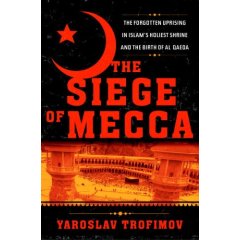 subtitle: The Forgotten Uprising in Islam’s Holiest Shrine and the Birth of Al Qaeda
subtitle: The Forgotten Uprising in Islam’s Holiest Shrine and the Birth of Al Qaeda
by Yaroslav Trofimov
Trofimov has a fascinating background. Born in 1969 in the Ukraine, he has been a reporter for many years, most recently covering the Middle East for the Wall Street Journal. Though he was barely ten years old when the events described in this book occurred, he has done an incredibly thorough job of researching, uncovering, and ferreting out the facts (against formidable obstacles) and reconstructing the events of November, 1979.
To say that 1979 was a turbulent year is to understate the obvious. In January of 1979, the Shah of Iran fled his country. In February of 1979, the Ayatollah Kohmeini returned to Iran from exile in France and took power as the head of a theocratic state in Iran. In the spring and summer of 1979, 70 percent of US gas stations shut down because they were out of fuel. Long lines of cars waited to get gas, and in some areas of the US there was rationing.
On November 4th of 1979, “revolutionary” students (Shiite followers of the Ayatollah Khomeini) in Tehran stormed the US embassy and took sixty-six US diplomatic personnel hostage.
On November 20th of 1979, a group of Sunni Wahabi fundamentalists seized control of Islam’s holiest shrine, the Grand Mosque of Mecca. Their leader was Juhayman al Uteybi, a retired corporal of the Saudi National Guard. The Whahabi fundamentalists were dissident critics of the Saudi royal house. They rejected any compromise with western or modern ways and were particularly outraged by the introduction of television to Saudi Arabia and to changes in the traditional, subservient roles assigned to women. Most of the Wahabi fundamentalists were descended from the Bedouins of Arabia – an ethnic group which had long been resentful of their conquest and oppression by the House of Saud.
It took the Saudi government two weeks to defeat the rebels and regain control of the Mosque. The 400 rebels came armed with rifles and grenades, and it eventually took the use of artillery and armored personnel carriers inside the Mosque to subdue them.
Less than a month after the uprising at the Grand Mosque, in December of 1979, the Soviet Union invaded Afghanistan. The Saudi government used the outrage of the Islamic world to divert the zeal of the Wahabi fundamentalists into a jihad against the Soviet Union in Afghanistan.
Although almost all the rebels who carried out the attack on the Grand Mosque were killed in battle or executed soon thereafter, they had many sympathizers and co-conspirators. Many of these traveled from Saudi Arabia to Afghanistan in the 1980’s to fight the Russians. They saw the humiliating defeat and withdrawal of the Russians in 1989 as simply one step in the grand cause of purifying Islam of Western influence and Islamic countries of all Western presence. After 1989, the jihadi’s turned their sights from Russia to the US, and after a decade’s campaign where they attacked the US in Africa and Arabia, they were prepared for a spectacular strike on the US itself.
This book serves three very valuable purposes. First is the reconstruction of the seizure of the Grand Mosque itself and the inept and uncoordinated struggle of the Saudi government to retake it. Second, the book contains a succinct and illuminating history of the kingdom of Saudi Arabia that will help everyone in the west to understand what a fragile coalition of competing tribal interests it is. For instance, I had not known that there are at least three separate major ethnic, tribal groups within Saudi Arabia – the Sunni tribes along the western, Red Sea shoreline, the Bedouin nomadic herdsman of the interior, and the Shia clans along the eastern, Persian Gulf shoreline. Each group is then further sub-divided along clan and family groups. Third, the book analyzes how the zeal of the Wahabi fundamentalists achieved international influence, allied first and foremost with a network of Egyptian plotters. These Wahabi fundamentalists (tolerated, subsidized, and feared by the Saudi monarchy) became the core of Al Qaeda.
Trofimov has done an incredible service for all those who want to understand the times and the conflict between Islam and the West which has dominated history for the last thirty years. Penetrating the reticence and secrecy of the Saudi kingdom is a formidable task. That Trofimov was able to track down so many eyewitnesses of the events of 1979 and piece together their accounts is astonishing.
I highly recommend this book for all those interested in understanding the times in which we live.
The Siege of Mecca can be ordered from Greenleaf Press by clicking here.
– Rob Shearer
Director, Schaeffer Study Center
Publisher, Greenleaf Press
